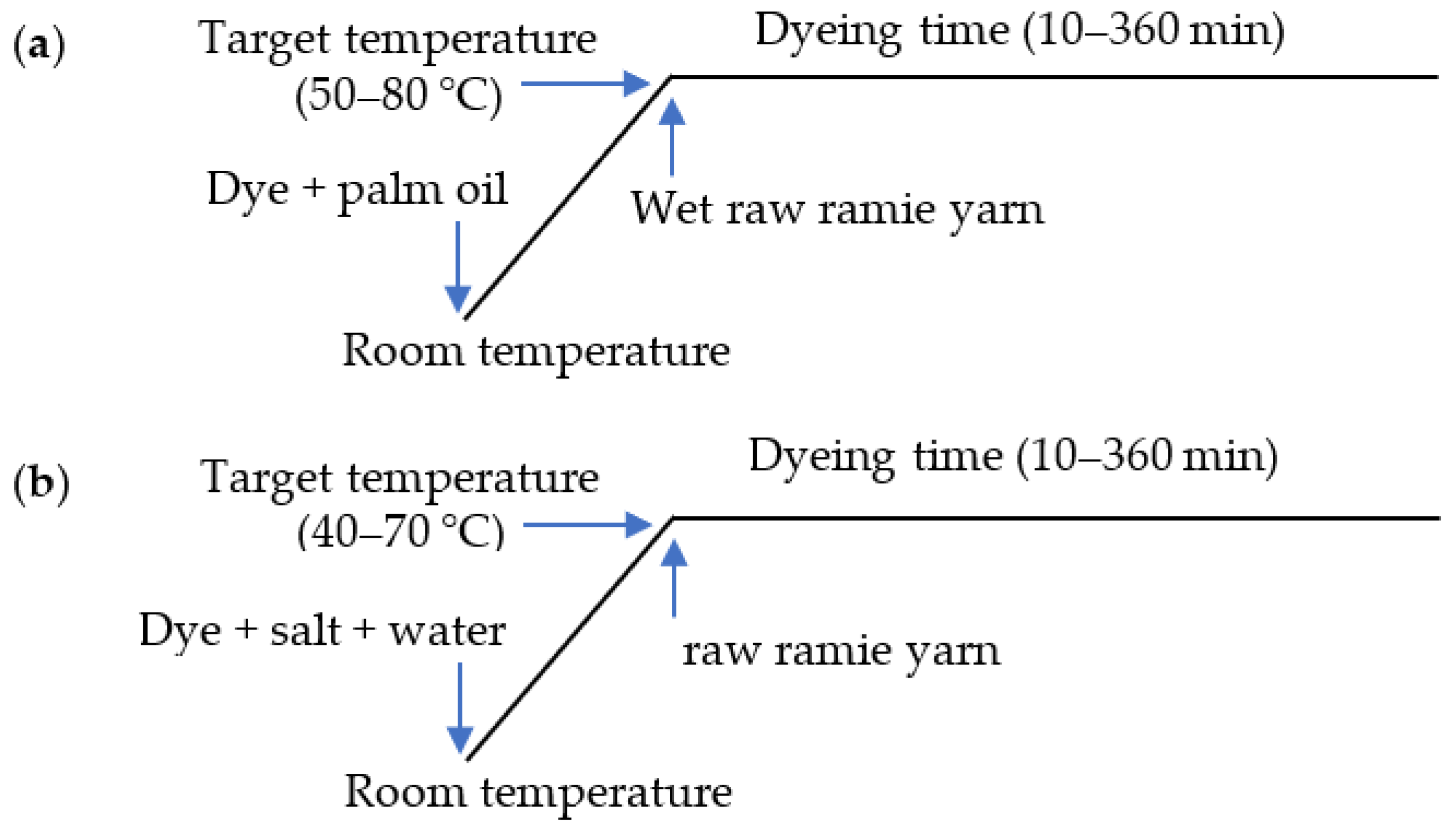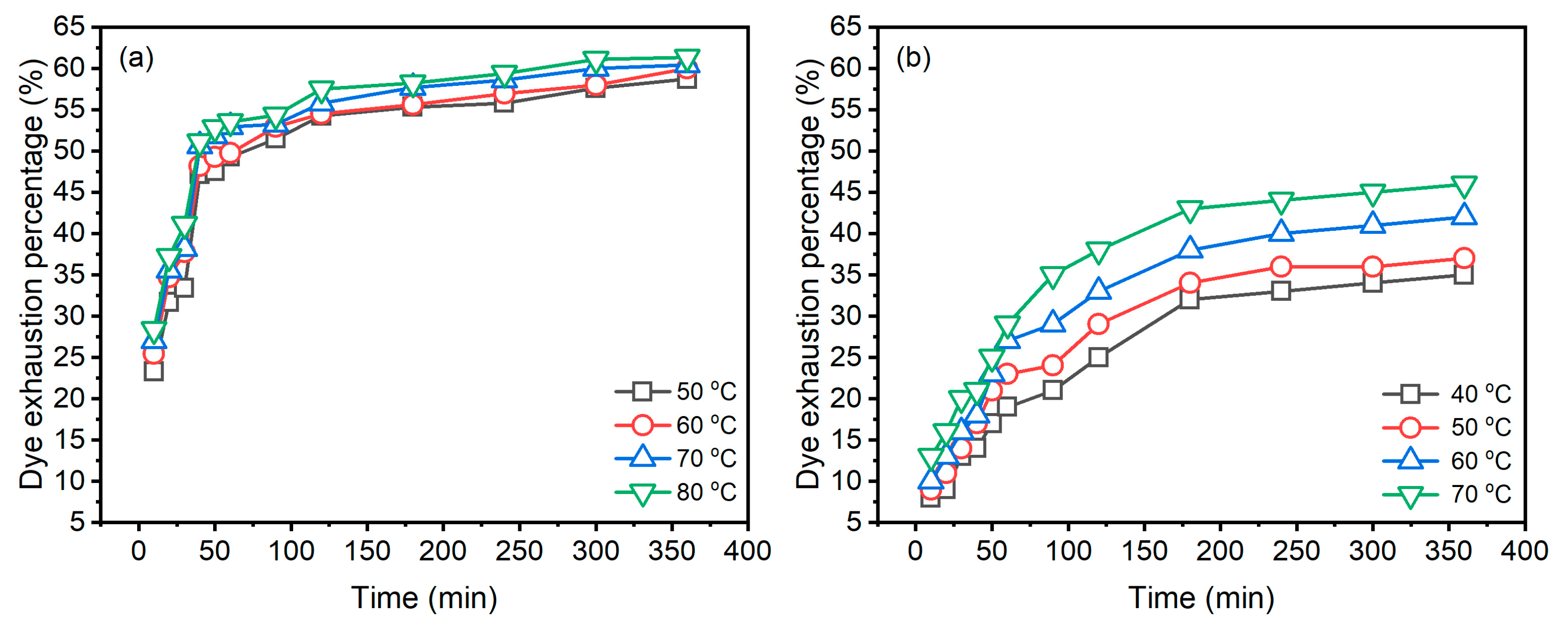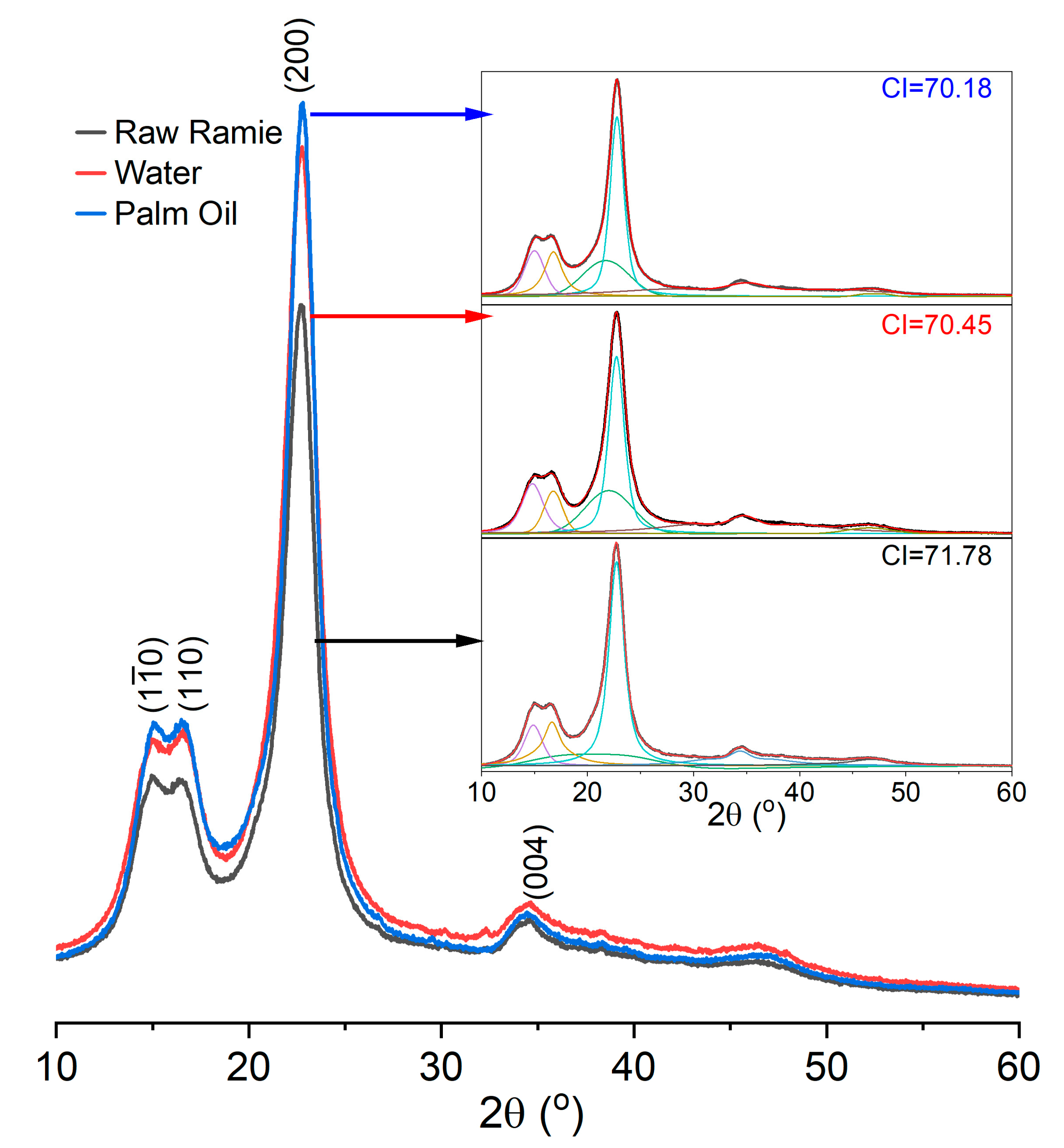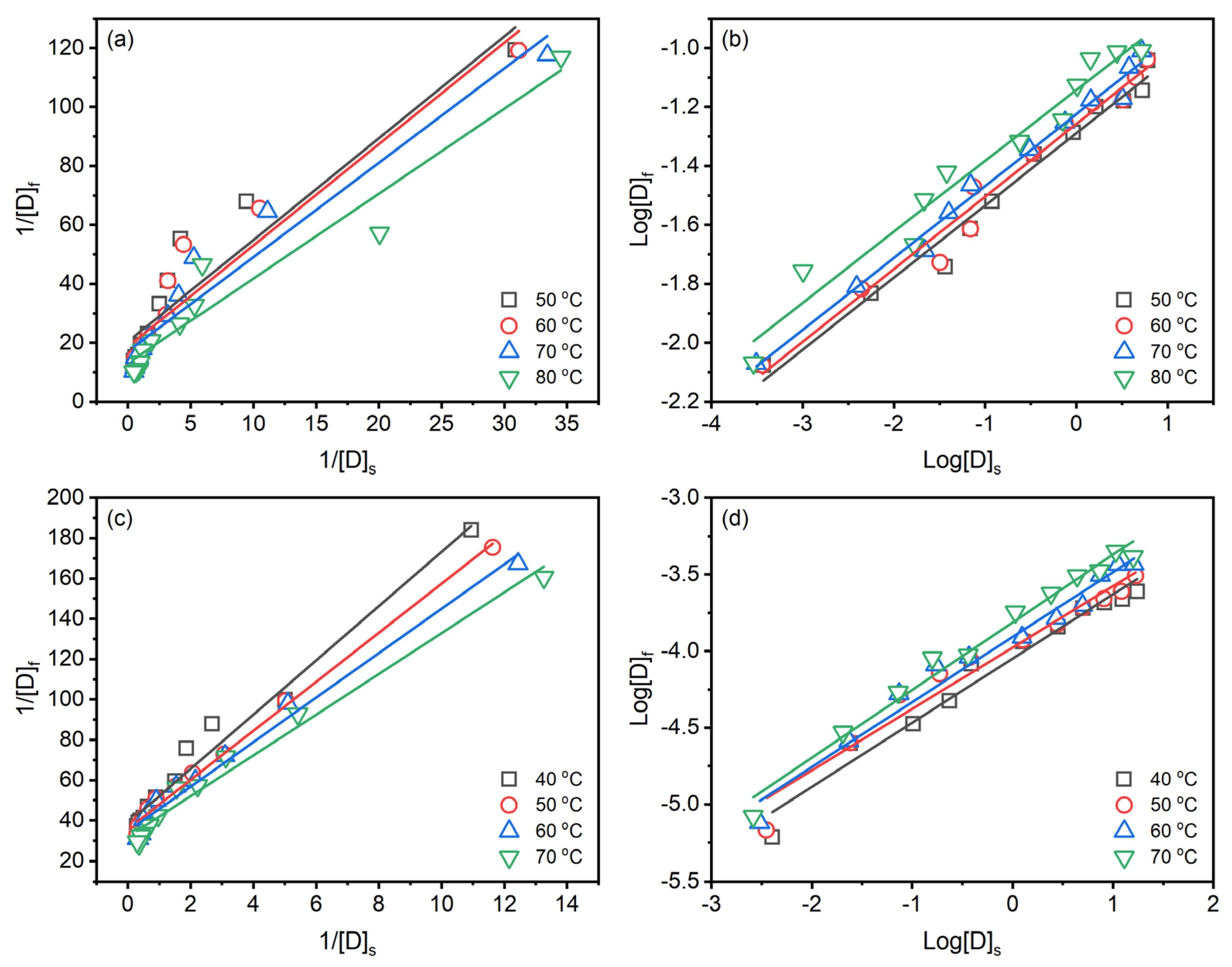Adsorption Behaviour of Reactive Blue 194 on Raw Ramie Yarn in Palm Oil and Water Media
Abstract
1. Introduction
2. Materials and Methods
2.1. Materials
2.2. Dyeing Process
2.3. Dye Exhaustion Percentage
2.4. X-ray Diffraction Analysis
3. Results and Discussion
3.1. Dye Adsorption Behaviour
3.2. Kinetic Analysis of Dye Adsorption
3.3. Half-Dyeing Time and Dye Diffusion Coefficient
3.4. Adsorption Isotherms
4. Conclusions
Author Contributions
Funding
Institutional Review Board Statement
Informed Consent Statement
Data Availability Statement
Acknowledgments
Conflicts of Interest
References
- Liao, J.; Yang, X. Study on the evolution of grass cloth. Asian Soc. Sci. 2016, 12, 109. [Google Scholar]
- Luo, G.; Lin, L. Research on the grass cloth embroidery regeneration development strategies in the information age. In Proceedings of the 2021 World Automation Congress (WAC), Taipei, Taiwan, 1–5 August 2021; IEEE: New York, NY, USA, 2021; pp. 254–259. [Google Scholar]
- Luo, G.; Lin, L.; Li, A. Cultural and Creative Tourism Product Design Strategies to Enhance the Brand Value of Intangible Cultural Heritage under Artificial Intelligence Technology: Focused on Grass Cloth Embroidery Example. In Proceedings of the 2021 International Conference on Forthcoming Networks and Sustainability in AIoT Era (FoNeS-AIoT), Nicosia, Turkey, 27–28 December 2021; IEEE: New York, NY, USA, 2021; pp. 160–167. [Google Scholar]
- Huang, H.; Tang, Q.; Lin, G.; Yu, C.; Wang, H.; Li, Z. High-efficiency and recyclable ramie cellulose fiber degumming enabled by deep eutectic solvent. Ind. Crops Prod. 2021, 171, 113879. [Google Scholar] [CrossRef]
- Lin, G.; Tang, Q.; Huang, H.; Yu, J.; Li, Z.; Ding, B. Process optimization and comprehensive utilization of recyclable deep eutectic solvent for the production of ramie cellulose fibers. Cellulose 2022, 29, 3689–3701. [Google Scholar] [CrossRef]
- Zhou, J.; Li, Z.; Yu, C. Property of ramie fiber degummed with Fenton reagent. Fibers Polym. 2017, 18, 1891–1897. [Google Scholar] [CrossRef]
- Zhang, P.; Zhang, C.; Jiang, T.; Hossain, M.Y.; Zhu, W.; Pervez, M.N.; Hoque, M.I.U.; Khan, I.; Long, X.; Cai, Y. Dyeing of raw ramie yarn with Reactive Orange 5 dye. Ind. Crops Prod. 2022, 176, 114315. [Google Scholar] [CrossRef]
- Lewis, D.M. The chemistry of reactive dyes and their application processes. In Handbook of Textile and Industrial Dyeing; Clark, M., Ed.; Woodhead Publishing: Sawston, UK, 2011; Volume 1, pp. 303–364. [Google Scholar]
- Inamdar, U.Y.; Pervez, M.N.; Navik, R.G.; Peng, X.; Cai, Y. Low-temperature bleaching of cotton fabric by activated peroxide system. Emerg. Mater. Res. 2017, 6, 387–395. [Google Scholar] [CrossRef]
- Lin, L.; Zhu, W.; Zhang, C.; Hossain, M.Y.; Oli, Z.B.S.; Pervez, M.N.; Sarker, S.; Hoque, M.I.U.; Cai, Y.; Naddeo, V. Combination of wet fixation and drying treatments to improve dye fixation onto spray-dyed cotton fabric. Sci. Rep. 2021, 11, 15403. [Google Scholar] [CrossRef]
- Lewis, D.M. Developments in the chemistry of reactive dyes and their application processes. Coloration Technol. 2014, 130, 382–412. [Google Scholar] [CrossRef]
- Anis, P.; Toprak, T.; Kutlu, E. Sericin assisted eco-friendly reactive dyeing for cotton fabric. Cellulose 2019, 26, 6317–6331. [Google Scholar] [CrossRef]
- Tang, P.; Lockett, L.-M.E.; Zhang, M.; Sun, G. Modification of cotton fabrics with 2-diethylaminoethyl chloride for salt-free dyeing with anionic dyes. Cellulose 2021, 28, 6699–6712. [Google Scholar] [CrossRef]
- Liu, L.; Mu, B.; Li, W.; Yang, Y. Cost-effective reactive dyeing using spent cooking oil for minimal discharge of dyes and salts. J. Clean. Prod. 2019, 227, 1023–1034. [Google Scholar] [CrossRef]
- Liu, L.; Mu, B.; Li, W.; Yang, Y. Semistable Emulsion System Based on Spent Cooking Oil for Pilot-Scale Reactive Dyeing with Minimal Discharges. ACS Sustain. Chem. Eng. 2019, 7, 13698–13707. [Google Scholar] [CrossRef]
- Liu, L.; Mu, B.; Li, W.; Xu, H.; Yang, J.; Yang, Y. Clean cotton dyeing in circulated dyebath of waste cooking oil: A feasible industrialization strategy for pollution minimization. J. Clean. Prod. 2021, 278, 123799. [Google Scholar] [CrossRef]
- Mu, B.; Li, W.; Xu, H.; Emanuel, L.; Yang, Y. Salt-free and environment-friendly reactive dyeing of cotton in cottonseed oil/water system. Cellulose 2019, 26, 6379–6391. [Google Scholar] [CrossRef]
- Tan, K.; Lee, K.; Mohamed, A.; Bhatia, S. Palm oil: Addressing issues and towards sustainable development. Renew. Sustain. Energy Rev. 2009, 13, 420–427. [Google Scholar] [CrossRef]
- Matthäus, B. Use of palm oil for frying in comparison with other high-stability oils. Eur. J. Lipid Sci. Technol. 2007, 109, 400–409. [Google Scholar] [CrossRef]
- Hinrichsen, N. Commercially available alternatives to palm oil. Lipid Technol. 2016, 28, 65–67. [Google Scholar] [CrossRef]
- Lin, L.; Xiao, L.; Li, L.; Zhang, C.; Pervez, M.N.; Naddeo, V.; Zhang, Y.; Islame, M.S.; Cai, Y.; Hassan, M.M. Sustainable and eco-friendly dyeing of traditional grass cloth with a reactive dye in palm oil medium. RSC Adv. 2022, 46, 29767–29776. [Google Scholar] [CrossRef]
- Lin, L.; Jiang, T.; Li, L.; Pervez, M.N.; Zhang, C.; Yan, C.; Cai, Y.; Naddeo, V. Sustainable traditional grass cloth fiber dyeing using the Taguchi L16 (4^4) orthogonal design. Sci. Rep. 2022, 12, 13833. [Google Scholar] [CrossRef]
- Masra, S.M.W.; Arief, Y.Z.; Sahari, S.K.; Muhammad, M.S.; Rigit, A.R.H.; Rahman, M.R. A Systematic Review on Promising Development of Palm Oil and Its Nanofluid as a Biodegradable Oil Insulation Alternative. IEEE Trans. Dielectr. Electr. Insul. 2022, 29, 302–318. [Google Scholar] [CrossRef]
- Lin, L.; Jiang, T.; Liang, Y.; Zhu, W.; Inamdar, U.Y.; Pervez, M.N.; Navik, R.; Yang, X.; Cai, Y.; Naddeo, V. Combination of Pre- and Post-Mercerization Processes for Cotton Fabric. Materials 2022, 15, 2092. [Google Scholar] [CrossRef] [PubMed]
- Lin, L.; Jiang, T.; Liang, Y.; Pervez, M.N.; Navik, R.; Gao, B.; Cai, Y.; Hassan, M.M.; Kumari, N.; Naddeo, V. Influence of Sequential Liquid Ammonia and Caustic Mercerization Pre-Treatment on Dyeing Performance of Knit Cotton Fabric. Materials 2022, 15, 1758. [Google Scholar] [CrossRef] [PubMed]
- Liang, Y.; Zhu, W.; Zhang, C.; Navik, R.; Ding, X.; Mia, M.S.; Pervez, M.N.; Mondal, M.I.H.; Lin, L.; Cai, Y. Post-treatment of reactive dyed cotton fabrics by caustic mercerization and liquid ammonia treatment. Cellulose 2021, 28, 7435–7453. [Google Scholar] [CrossRef]
- Zhang, P.; Zhu, W.; Hossain, M.Y.; Sarker, S.; Pervez, M.N.; Mondal, M.I.H.; Yan, C.; Cai, Y.; Naddeo, V. Toward improved performance of reactive dyeing on cotton fabric using process sensitivity analysis. Int. J. Cloth. Sci. Technol. 2022, 34, 469–484. [Google Scholar] [CrossRef]
- Pervez, M.N.; Chen, C.; Li, Z.; Naddeo, V.; Zhao, Y. Tuning the structure of cerium-based metal-organic frameworks for efficient removal of arsenic species: The role of organic ligands. Chemosphere 2022, 303, 134934. [Google Scholar] [CrossRef]
- Talukder, M.E.; Pervez, M.N.; Jianming, W.; Gao, Z.; Stylios, G.K.; Hassan, M.M.; Song, H.; Naddeo, V. Chitosan-functionalized sodium alginate-based electrospun nanofiber membrane for As(III) removal from aqueous solution. J. Environ. Chem. Eng. 2021, 9, 106693. [Google Scholar] [CrossRef]
- Hossain, M.Y.; Zhu, W.; Pervez, M.N.; Yang, X.; Sarker, S.; Hassan, M.M.; Hoque, M.I.U.; Naddeo, V.; Cai, Y. Adsorption, kinetics, and thermodynamic studies of cacao husk extracts in waterless sustainable dyeing of cotton fabric. Cellulose 2021, 28, 2521–2536. [Google Scholar] [CrossRef]
- Cai, Y.; Huang, Y.; Liu, F.; He, L.; Lin, L.; Zeng, Q. Liquid ammonia dyeing of cationic ramie yarn with triazinyl reactive dyes. Cellulose 2014, 21, 3841–3849. [Google Scholar] [CrossRef]
- Pervez, M.N.; Fu, D.; Wang, X.; Bao, Q.; Yu, T.; Naddeo, V.; Tian, H.; Cao, C.; Zhao, Y. A bifunctional α-FeOOH@GCA nanocomposite for enhanced adsorption of arsenic and photo Fenton-like catalytic conversion of As(III). Environ. Technol. Innov. 2021, 22, 101437. [Google Scholar] [CrossRef]
- Ho, Y.-S. McKay, Gordon, Pseudo-second order model for sorption processes. Process Biochem. 1999, 34, 451–465. [Google Scholar] [CrossRef]
- Wang, X.; Song, Z.; Hao, J.; Mingmei, X. Dyeing thermodynamics of acrylic acid photografted linen fabric with cationic dyes. J. Text. Res. 2012, 33, 49–52. [Google Scholar]
- Inyinbor, A.A.; Adekola, F.A.; Olatunji, G.A. Kinetics, isotherms and thermodynamic modeling of liquid phase adsorption of Rhodamine B dye onto Raphia hookerie fruit epicarp. Water Resour. Ind. 2016, 15, 14–27. [Google Scholar] [CrossRef]
- Liu, Y.; Li, J.; Cheng, X.; Ren, X.; Huang, T.S. Self-assembled antibacterial coating by N-halamine polyelectrolytes on a cellulose substrate. J. Mater. Chem. B 2015, 3, 1446–1454. [Google Scholar] [CrossRef] [PubMed]
- Shen, D.; Fan, J.; Zhou, W.; Gao, B.; Yue, Q.; Kang, Q. Adsorption kinetics and isotherm of anionic dyes onto organo-bentonite from single and multisolute systems. J. Hazard. Mater. 2009, 172, 99–107. [Google Scholar] [CrossRef] [PubMed]
- Abraham, R.; Mathew, S.; Kurian, S.; Saravanakumar, M.; Ealias, A.M.; George, G. Facile synthesis, growth process, characterisation of a nanourchin-structured α-MnO2 and their application on ultrasonic-assisted adsorptive removal of cationic dyes: A half-life and half-capacity concentration approach. Ultrason. Sonochem. 2018, 49, 175–189. [Google Scholar] [CrossRef]
- Sari, A.; Mendil, D.; Tuzen, M.; Soylak, M. Biosorption of palladium(II) from aqueous solution by moss (Racomitrium lanuginosum) biomass: Equilibrium, kinetic and thermodynamic studies. J. Hazard. Mater. 2009, 162, 874–879. [Google Scholar] [CrossRef]
- Ramesh, A.; Hasegawa, H.; Sugimoto, W.; Maki, T.; Ueda, K. Adsorption of gold(III), platinum(IV) and palladium(II) onto glycine modified crosslinked chitosan resin. Bioresour. Technol. 2008, 99, 3801–3809. [Google Scholar] [CrossRef]
- Cai, Y.; Liang, Y.; Navik, R.; Zhu, W.; Zhang, C.; Pervez, M.N.; Wang, Q. Improved reactive dye fixation on ramie fiber in liquid ammonia and optimization of fixation parameters using the Taguchi approach. Dye. Pigment. 2020, 183, 108734. [Google Scholar] [CrossRef]
- Haque, A.N.M.A.; Remadevi, R.; Rojas, O.J.; Wang, X.; Naebe, M. Kinetics and equilibrium adsorption of methylene blue onto cotton gin trash bioadsorbents. Cellulose 2020, 27, 6485–6504. [Google Scholar] [CrossRef]
- Gao, B.; Huang, X.; Jiang, T.; Pervez, M.N.; Zhu, W.; Hassan, M.M.; Cai, Y.; Naddeo, V. Sustainable dyeing of ramie fiber with ternary reactive dye mixtures in liquid ammonia. RSC Adv. 2022, 12, 19253–19264. [Google Scholar] [CrossRef]
- Yuan, C.; Lou, K.; Yu, L.; Pervez, M.N.; Su, S.; Huang, J.; Peng, X.; Cai, Y. Electrolyte influence on sorption behaviours of Direct Blue 71 dye on ramie fibre. MATEC Web Conf. 2017, 108, 03003. [Google Scholar] [CrossRef]







| Temp. (°C) | qe(exp.) (mg g−1) | Pseudo-First-Order | Pseudo-Second-Order | ||||
|---|---|---|---|---|---|---|---|
| K1 (min−1) | qe(cal1) (mg g−1) | K2 (g mg−1 min−1) | qe(cal2) (mg g−1) | ||||
| Palm oil medium | |||||||
| 50 | 17.6098 | 0.0105 | 7.2044 | 0.8982 | 0.0034 | 18.1159 | 0.9986 |
| 60 | 18.0038 | 0.0086 | 6.5398 | 0.8763 | 0.0041 | 18.2236 | 0.9995 |
| 70 | 18.1304 | 0.0126 | 7.2109 | 0.9280 | 0.0040 | 18.6916 | 0.9991 |
| 80 | 18.3978 | 0.0137 | 7.5337 | 0.9116 | 0.0042 | 18.9394 | 0.9994 |
| Water medium | |||||||
| 40 | 10.4950 | 0.0054 | 10.1812 | 0.9840 | 0.0011 | 12.6904 | 0.9923 |
| 50 | 11.0913 | 0.0056 | 9.8969 | 0.9796 | 0.0014 | 12.9702 | 0.9914 |
| 60 | 12.6045 | 0.0054 | 11.2176 | 0.9956 | 0.0014 | 14.7059 | 0.9926 |
| 70 | 13.6881 | 0.0051 | 11.0027 | 0.9913 | 0.0013 | 15.6250 | 0.9925 |
| Temperature (°C) | t1/2 (min) | D × 1011 (m2 min−1) |
|---|---|---|
| Palm oil medium | ||
| 50 | 16.08 | 1.8576 |
| 60 | 13.55 | 2.2044 |
| 70 | 13.44 | 2.2224 |
| 80 | 12.53 | 2.3838 |
| Water medium | ||
| 40 | 70.82 | 0.4218 |
| 50 | 55.99 | 0.5335 |
| 60 | 49.75 | 0.6004 |
| 70 | 49.40 | 0.6046 |
| Temperature (°C) | 50 | 60 | 70 | 80 |
|---|---|---|---|---|
| Langmuir isotherm | ||||
| [S]f (g g−1) | 0.0490 | 0.0536 | 0.0584 | 0.0764 |
| KL | 5.9106 | 5.4205 | 5.3417 | 4.5486 |
| 0.8950 | 0.9147 | 0.9402 | 0.9441 | |
| Average: 0.9235 | ||||
| Freundlich isotherm | ||||
| n | 4.0811 | 4.0556 | 4.0932 | 4.1559 |
| KF | 0.0515 | 0.0553 | 0.0598 | 0.0722 |
| 0.9794 | 0.9769 | 0.9888 | 0.9644 | |
| Average: 0.9774 | ||||
| Temperature (°C) | 40 | 50 | 60 | 70 |
|---|---|---|---|---|
| Langmuir isotherm | ||||
| [S]f (mg g−1) | 0.0259 | 0.0279 | 0.0289 | 0.0314 |
| KL | 2.8742 | 2.9455 | 3.1435 | 3.1543 |
| 0.9770 | 0.9947 | 0.9824 | 0.9793 | |
| Average: 0.9833 | ||||
| Freundlich isotherm | ||||
| n | 2.3892 | 2.4932 | 2.3587 | 2.2647 |
| KF | 0.0001 | 0.0001 | 0.0001 | 0.0002 |
| 0.9688 | 0.9600 | 0.9735 | 0.9833 | |
| Average: 0.9714 | ||||
Publisher’s Note: MDPI stays neutral with regard to jurisdictional claims in published maps and institutional affiliations. |
© 2022 by the authors. Licensee MDPI, Basel, Switzerland. This article is an open access article distributed under the terms and conditions of the Creative Commons Attribution (CC BY) license (https://creativecommons.org/licenses/by/4.0/).
Share and Cite
Lin, L.; Li, L.; Xiao, L.; Zhang, C.; Li, X.; Pervez, M.N.; Zhang, Y.; Nuruzzaman, M.; Mondal, M.I.H.; Cai, Y.; et al. Adsorption Behaviour of Reactive Blue 194 on Raw Ramie Yarn in Palm Oil and Water Media. Materials 2022, 15, 7818. https://doi.org/10.3390/ma15217818
Lin L, Li L, Xiao L, Zhang C, Li X, Pervez MN, Zhang Y, Nuruzzaman M, Mondal MIH, Cai Y, et al. Adsorption Behaviour of Reactive Blue 194 on Raw Ramie Yarn in Palm Oil and Water Media. Materials. 2022; 15(21):7818. https://doi.org/10.3390/ma15217818
Chicago/Turabian StyleLin, Lina, Le Li, Lexin Xiao, Cong Zhang, Xueqing Li, Md. Nahid Pervez, Youqing Zhang, Md. Nuruzzaman, Md. Ibrahim H. Mondal, Yingjie Cai, and et al. 2022. "Adsorption Behaviour of Reactive Blue 194 on Raw Ramie Yarn in Palm Oil and Water Media" Materials 15, no. 21: 7818. https://doi.org/10.3390/ma15217818
APA StyleLin, L., Li, L., Xiao, L., Zhang, C., Li, X., Pervez, M. N., Zhang, Y., Nuruzzaman, M., Mondal, M. I. H., Cai, Y., & Naddeo, V. (2022). Adsorption Behaviour of Reactive Blue 194 on Raw Ramie Yarn in Palm Oil and Water Media. Materials, 15(21), 7818. https://doi.org/10.3390/ma15217818









